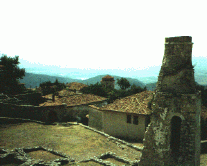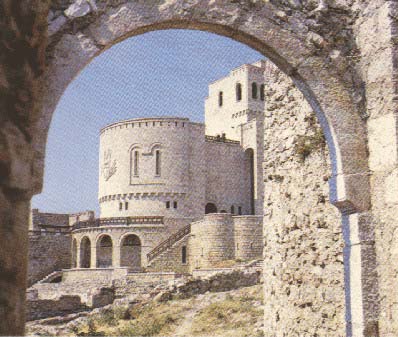Albania
> Kruja
You come into Kruja (pronounced: Kru-yah) past
age-old olive trees and lime-kilns, with limestone
outcrops offering the barest grazing to a few
sheep and goats. Then shrubs and oaks replace
the olives, and finally the conifers take over.
"Kruj'" means "Spring" and of course there is
no shortage of fresh water at these cool heights.
The air invigorates you after the hot, humid plain
of Tirana, and one can easily imagine why the
old Ilyrrian settlement of Zg'rdhesh was abandoned
in the forth century, and the refugees from the
hotter, more exposed foothills chose to defend
a mountain eyrie instead.
The ecclesiastical record of the ninth century
mentioned Kruj' as a bishop's see. The byzantine
held the city up to c.1190, when the first Albanian
feudal state was declared at Kruj' under the archon
Progon (1190-8). Arbania survived throughout the
rule of Progon's son Gjin (1198-1206) and Dhimitrit
(1206-16), but in 1216 it fell under the sway
of Epiros, in 1230 under Bulgarians, and in 1240
again under Epiros. Foreign invaders continue
to fight over the dying body of a torn and bleeding
Albania until an Ottoman garrison was permanently
stationed at Kruj' in 1415.

|
The youngest of Gjon Kastrioti's four sons, Gjergj,
was sent with his three brothers as a hostage to
the Sultan at Constantinople in 1415. He impressed
his tutors at the military school he attended and
they gave him the title "Skender-beg" for the valour
on the field of battle. Then in 1443 he suddenly
left the Ottoman army fighting Hunyadi, the Hungarian
Hero and returned to Albania. As the Turks retreated
near Nish on 3 November 1443, Gjergj withdrew his
nephew Hamza and 300 Albanian horsemen and headed
for Dib'r and then Kruj'.
The citadel of Kruj' became the scene of one of
Europe's most titanic struggles. In May 1450 the
Ottoman Sultan Murad II set out from Constantinople
with a hundred thousand men to crush once and
for all the Albanian army which had been united
since 1444 by Skenderbeg's personal recruiting
campaign. He aimed to storm the citadel of Kruj'
and to hold the Albanian countryside with Kruj'
as a capital. Skenderbeg's personal magnetism
ensured that those Albanians fit to take up arms
were armed and ready for combat, a total of 17,500
at the most, who were thus outnumbered by five
to one. Skenderbeg divided his troops into three
bands. Fifteen hundred led by Count Uran were
provisioned to withstand the siege within the
citadel itself. The two major forces of 8 000
each were split up, the first under Skenderbeg
to harry the near of the Ottoman army once it
had encamped below Kruj', and the other forming
small bands of guerrilleros to ambush, raid, and
snipe at the Turkish caravan on its cumbersome
trail from Macedonia. Since Murad II realised
that his troops would mutiny if ordered to withstand
the hostile winter encamped in a trap below Kruj',
after four and a half months he retreated with
loses estimated at more than twenty thousand -
that is exceeding the strength of the whole Albanian
army. Ragusa congratulated Skenderbeg, "Magnificus
et Potens" on his stupendous victory.

The remains of the castle and its surroundings
|
Kruja under the direction of Skenderbeg defeated
the turkish army lead by the Sultan Mehmet etc.
for a quarter of a century. As the British military
strategist Wolfe has said Skenderbeg surpassed "all
the captains, both ancient and modern, in his ability
to lead a small defensive army". After the death
of Skenderbeg from natural causes in 1468, the citadel
of Kruj' defeated the Turks for more then ten years
under the direction of Lek' Dugagjin till at 16
june 1478 when it fell definitively to the Sultan
Mehmet.

The remains of the tower and the new museum
|
After the Ottoman took their dearly-won castle of
Kruj', they rebuild the walls on the northern side,
with openings for firearms, to make Kruj' as impregnable
against the Albanians as it had been impregnable
against themselves. The earthquake of 1617 caused
the cracking and collapse of many hill structures,
including the citadel, but in 1832, on the Sultan's
orders, the Albanian feudal castles were made useless
for defence and a centralised bureaucratic government
replaced - at least in intention - the former feudal
semi-autonomy of the mountain regions as Kruj'.
Half-hearted attempts were made by the Turks to
rebuild sections of the castle, after they have
tightened their grip on the countryside, for they
realised that sudden Balkan uprisings could overwhelm
their government, and a defenceless castle is a
doubtful asset to a ruling class.
Points
of Touristic Interest

The Skenderbeg Museum |
- The
Restored Castle and Citadel
- The
Skenderbeg Museum erected in the middle of the
Castle.
- The
Old restored Bazaar near the castle.
- The
jewel eighteen-century architecture Bektashi
tekke "Dollma" (West of the castle), a shrine
of the Bektashi movement, one of the fourth
main religions of Albania after the Catholics,
the Orthodox, and Muslims.
|